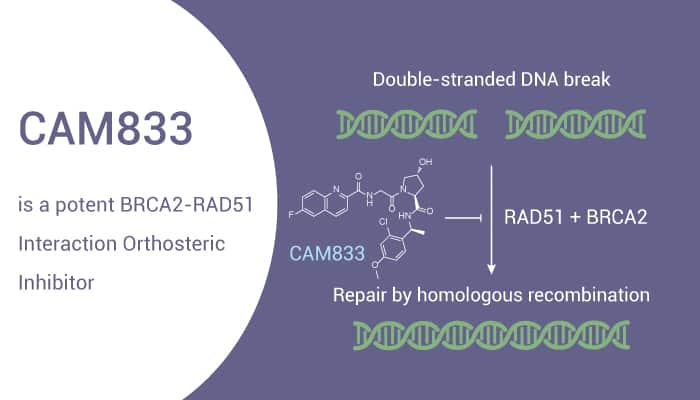RAD51, an essential eukaryotic DNA recombinase, promotes homologous pairing and strand exchange during homologous recombination (HR) and the recombinational repair of double-strand breaks. RAD51 protein is recruited onto the DNA break by BRCA2 and forms homopolymeric filaments that invade the homologous chromatid and use it as a template for repair. Thus, RAD51 is an essential gene that protects cells from genetic instability. Specifically, RAD51 protects under-replicated DNA in mitotic human cells and, in this way, promotes mitotic DNA synthesis (MiDAS) and successful chromosome segregation. Besides, RAD51 recombinase activity plays a critical role in cancer cell proliferation and survival and often contributes to drug resistance.
Unrepaired DNA damage can result in genome instability and cancer. Therefore, the regulation of HR is central to cancer prevention. Too little HR can increase cancer incidence, whereas too much HR can drive cancer resistance to therapy. RAD51 is central to DNA damage repair in the homologous HR pathway. While loss or reduction of RAD51 protein function can increase cancer risk, RAD51 upregulation in cancer can also contribute to therapeutic resistance. Maintaining appropriate levels of RAD51 expression and activity is critical for HR and thus cancer prevention. As such, understanding the function and regulation of RAD51 is essential for cancer biology.
CAM833 is a potent and selective inhibitor of the BRCA2-RAD51 interaction.

Crystal structure shows CAM833 binds RAD51 at the same site as the BRCA2 FxxA motif to inhibit the DNA recombinase RAD51-mediated homologous recombination. Specifically, CAM833 blocks formation of RAD51 foci and filaments, preventing DNA repair. Meanwhile, CAM833 potentiates cytotoxicity by IR and synergises with PARP1 inhibitors. What’s more, CAM833 has no significant off-target interactions when screened at 10 μM in the Cerep ExpresSPanel.
All in all, CAM833 is a potent and selective inhibitor of the BRCA2-RAD51 interaction. CAM833 has the potential for the cancer research.
Reference:
[1]. Wassing IE, et, al. Nat Commun. 2021 Sep 10;12(1):5380.
[2]. Laurini E, et, al. Pharmacol Ther. 2020 Apr;208:107492.